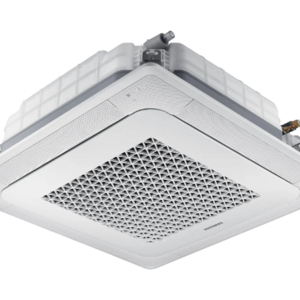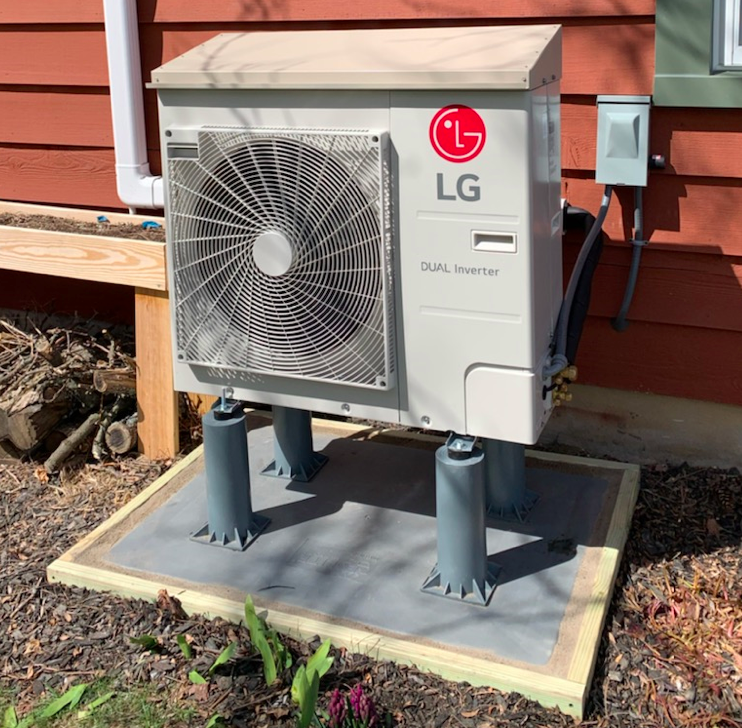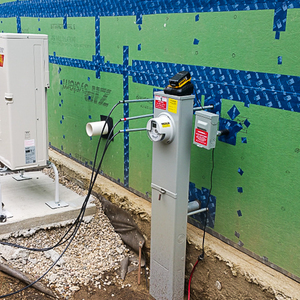
Have you ever used a flashlight to look up into the part of a ductless minisplit where the air blows out? I should have done that a lot sooner than I did. It turns out these heat pumps can get nasty dirty inside. That photo above is from the inside of my wall-mounted ductless unit. Down below you’ll find a video I made about this issue, including how we cleaned it. But first, let’s talk about why this happens.
The causes
There are really four factors that lead to ductless minisplits getting so filthy. First, they don’t have good filtration. The air passes through a pretty thin filter that doesn’t fit tightly across the coil. So dirty air comes through and finds cold, wet surfaces to stick to.
Second, where the air comes out at the bottom of the unit is open to the room. That means humid, dirty air can reach the cold surfaces within. So if there weren’t enough dirt and moisture there already, now we’ve got more.
Third, the blower is downstream from the cooling coil. So it gets cold—really cold—and becomes an excellent condensing surface. Put all that together and you get some nasty dirty surfaces inside the unit.
The blower wheel takes the brunt of it because it’s the thing that’s moving the air. All those cold, wet blades are pushing the air and removing the particles. I guess it’s a kind of filtration, but when you look at that photo above, you’ll probably agree with me that it’s not the kind you want.
And fourth, humid climates provide a lot of airborne water to wet things down. You can still get a dirty minisplit in a dry climate, but it probably won’t get as bad or happen as quickly.
The fix
Well, there’s just one thing to do and that’s clean it. Or hire someone to clean it for you. In the video below, you can see how we cleaned my ductless minisplit. We bought two things: a small pressure washer made for cleaning coils and a plastic shroud with built-in funnel to keep the water where we wanted it. It worked really well, as you can see by all the dirt we got out of my minisplit and how clean it was afterward.
Unfortunately, most ductless minisplits aren’t made for ease of cleaning. Edward Louie, an engineer at Pacific Northwest National Lab, has been pushing hard for manufacturers to improve in this area. He and I both gave talks at a conference in Portland, Oregon, earlier this year, and I saw him disassemble and remove the blower wheel from a ductless minisplit in less than ten minutes. He also recently posted on LinkedIn about four manufacturers that make it easy to remove the blower wheel.
Now, if you’re brave enough, go get your flashlight and take a look at yours. You really shouldn’t let it go four years like I did.
____________________________________________________________________
Allison A. Bailes III, PhD is a speaker, writer, building science consultant, and the founder of Energy Vanguard in Decatur, Georgia. He has a doctorate in physics and is the author of a bestselling book on building science. He also writes the Energy Vanguard Blog. For more updates, you can follow Allison on LinkedIn and subscribe to Energy Vanguard’s weekly newsletter and YouTube channel.
Weekly Newsletter
Get building science and energy efficiency advice, plus special offers, in your inbox.














9 Comments
What's the specific compressor/sprayer setup you used? At what pressure?
I was expecting you'd wash the water through the opposite direction to the airflow, but it seemed like this worked fine.
He links in the article to the machine:
https://trutechtools.com/supco-zpb140-port-a-blaster-coil-cleaning-machine.html?aff=10
Charlie: Actually we did clean through the direction opposite the air flow. Notice I was spraying up through the bottom. The return air comes in the top, crosses the coil, and gets blown out the bottom.
It seems to me there's no technical reason minisplits couldn't have high quality replaceable filters and this would all be avoided.
DCcontrarian: Well, would it really eliminate the problem? Because it's ductless, the room air has easy access to the blower wheel. The coil and filter were actually pretty clean. What would be nice, though, is if they were easy to disassemble and clean. If a homeowner could pop the blower wheel out and throw it in the dishwasher, that would be a huge improvement.
There are thousands of consumer appliances, from automobiles to dryers to lawnmowers to dehumidifiers, where popping out the air filter from time to time and either replacing it or cleaning it is just part of the routine.
Let me turn the question around: what sets a minisplit apart from those other appliances, that disassembling it and cleaning it is better than replacing a filter from time to time?
In Japan, the home of the minisplit, commercial cleaners charge under $100 per unit or a little more for units with self-dust cleaning functions (moving them out of the way takes time).
I've partially disassembled Daikin, Panasonic, Fujitsu and Mitsubishi ones and all were similar once you get used to it. You can remove the blower wheel and clean it thoroughly in the shower and then use a spray cleaner on the foil. (the method described above is preferable if you get the equipment for it and what the commercial cleaners use).
The most expensive unit I have, a Daikin, was also the most fragile with small plastic parts that don't really withstand repeated removal but it's working fine even with some broken plastic tabs. An older Mitsubishi I had was the easiest to disassemble and the one I first learned how to take apart by watching YouTube videos.
I clean mine after each cooling season which is when mold accumulates. I also use a 3M PM filter on the outside of the case to pre-filter dust before it makes its way into the aircon, giving mold fewer surfaces to grow on.
Tried cleaning mine myself after only a year and a half of use they were full of “growth.” Asked an HVAC buddy of mine on best methods for cleaning and he said they always remove the blower wheels.
I attempted, but no luck. I couldn’t get that thing off no matter what I tried and became nervous of breaking something. I ended up paying the pros (they got it all disassembled but I wasn’t around to watch) Maybe next year I’ll have to try the pressure washer and shroud.
Nice very well .
Softside Bathtub Cushion
Log in or create an account to post a comment.
Sign up Log in